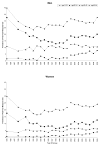Trends in U.S., past-year marijuana use from 1985 to 2009: an age-period-cohort analysis
- PMID: 22361212
- PMCID: PMC4109063
- DOI: 10.1016/j.drugalcdep.2012.01.020
Trends in U.S., past-year marijuana use from 1985 to 2009: an age-period-cohort analysis
Abstract
Background: We present a formal age-period-cohort analysis to examine if the recent increase in past-year marijuana use among the young is specific to the younger generation or if, instead, it is part of a general increase present across cohorts of all ages. This is the first age-period-cohort analysis of past-year marijuana use that includes adult trends from 2001 to 09.
Methods: Data come from the National Survey on Drug Use and Health, a series of annual, nationally representative, cross-sectional surveys of the U.S. civilian, non-institutionalized population. The analysis focuses on the 25 year time span from 1985 to 2009 and uses the recently developed 'intrinsic estimator' algorithm to estimate independent effects of age, period, and cohort.
Results: The recent increase in past-year marijuana use is not unique to the youngest birth cohorts. An independent, positive influence of cohort membership on past-year marijuana use, net of historical period and age effects, is smaller for today's youngest cohorts than it was for the cohorts that came immediately before, and, in fact, is at its lowest level in three decades. The recent increase in marijuana use among the young is more consistent with a historical period effect that has acted across all cohorts. Period and cohort trends differ substantially for Hispanics.
Conclusions: The major forces that drive trends in past-year marijuana use are moving away from cohort-specific factors and toward broad-based influences that affect cohorts of all ages. Strategic public health and policy efforts aimed at addressing the recent increase in past-year marijuana use should do the same.
Copyright © 2012 Elsevier Ireland Ltd. All rights reserved.
Figures



Similar articles
-
Increasing use of nonmedical analgesics among younger cohorts in the United States: a birth cohort effect.J Adolesc Health. 2013 Jan;52(1):35-41. doi: 10.1016/j.jadohealth.2012.07.016. Epub 2012 Oct 15. J Adolesc Health. 2013. PMID: 23260832 Free PMC article.
-
Age-period-cohort influences on trends in past year marijuana use in the US from the 1984, 1990, 1995 and 2000 National Alcohol Surveys.Drug Alcohol Depend. 2007 Jan 12;86(2-3):132-8. doi: 10.1016/j.drugalcdep.2006.05.022. Epub 2006 Jun 27. Drug Alcohol Depend. 2007. PMID: 16806739
-
Past-month cannabis use among U.S. individuals from 2002-2015: An age-period-cohort analysis.Drug Alcohol Depend. 2018 Dec 1;193:177-182. doi: 10.1016/j.drugalcdep.2018.05.035. Epub 2018 Oct 17. Drug Alcohol Depend. 2018. PMID: 30384326 Free PMC article.
-
Past 15-year trends in adolescent marijuana use: Differences by race/ethnicity and sex.Drug Alcohol Depend. 2015 Oct 1;155:8-15. doi: 10.1016/j.drugalcdep.2015.08.025. Epub 2015 Sep 2. Drug Alcohol Depend. 2015. PMID: 26361714 Free PMC article.
-
Trends and age, period and cohort effects for marijuana use prevalence in the 1984-2015 US National Alcohol Surveys.Addiction. 2018 Mar;113(3):473-481. doi: 10.1111/add.14031. Epub 2017 Oct 11. Addiction. 2018. PMID: 28895239 Free PMC article.
Cited by
-
Changes over time in marijuana use, deviant behavior and preference for risky behavior among US adolescents from 2002 to 2014: testing the moderating effect of gender and age.Addiction. 2019 Apr;114(4):674-686. doi: 10.1111/add.14506. Epub 2018 Dec 18. Addiction. 2019. PMID: 30461115 Free PMC article.
-
Association of marijuana smoking with oropharyngeal and oral tongue cancers: pooled analysis from the INHANCE consortium.Cancer Epidemiol Biomarkers Prev. 2014 Jan;23(1):160-71. doi: 10.1158/1055-9965.EPI-13-0181. Epub 2013 Dec 18. Cancer Epidemiol Biomarkers Prev. 2014. PMID: 24351902 Free PMC article.
-
Age of Sexual Debut and Cannabis Use in the United States.Subst Use Misuse. 2016;51(4):439-48. doi: 10.3109/10826084.2015.1110177. Epub 2016 Feb 16. Subst Use Misuse. 2016. PMID: 26881806 Free PMC article.
-
Shifting Cohort Patterns in the Use of Drugs with Elevated Overdose Risk in the United States.Soc Probl. 2025 Aug;72(3):1239-1259. doi: 10.1093/socpro/spae013. Epub 2024 Mar 25. Soc Probl. 2025. PMID: 40785729 Free PMC article.
-
Developing explanatory models for life course shifts in the burden of substance use to inform future policy and practice.Int J Drug Policy. 2021 Aug;94:103182. doi: 10.1016/j.drugpo.2021.103182. Epub 2021 Mar 6. Int J Drug Policy. 2021. PMID: 33685803 Free PMC article.
References
-
- Bachman JG, Johnston L, O’Malley PM, Humphrey RH. Explaining the recent decline in marijuana use: Differentiating the effects of perceived risks, disapproval, and general lifestyle factors. J Health Soc Behav. 1988;29:92–112. - PubMed
-
- Erickson PG, Hathaway AD. Normalization and Harm Reduction: Research Avenues and Policy Agendas. International Journal of Drug Policy. 2010;21:137–139. - PubMed
-
- Gassoumis ZD, Wilber KH, Baker LA, Torres-Gil FM. Who Are The Latino Baby Boomers? Demographic and Economic Characteristics of a Hidden Population. J Aging Soc Policy. 2010;22:53–68. - PubMed
-
- Glenn N. Distinguishing Age, Period, and Cohort Effects. In: Mortimer JT, Shanahan MJ, editors. The Handbook of the Life Course. Kluwer Academic/Plenum; New York: 2003. pp. 465–476.
MeSH terms
Grants and funding
LinkOut - more resources
Full Text Sources
Miscellaneous

